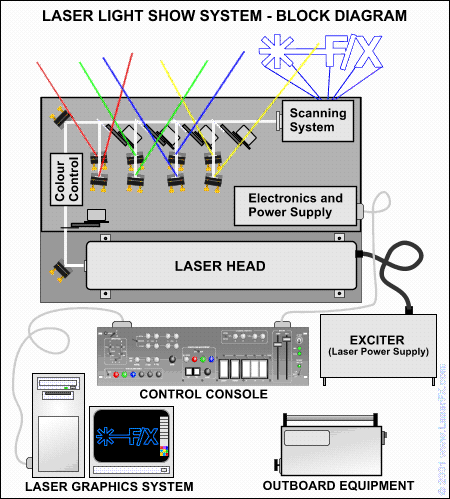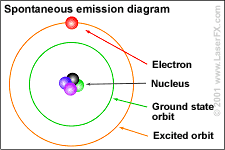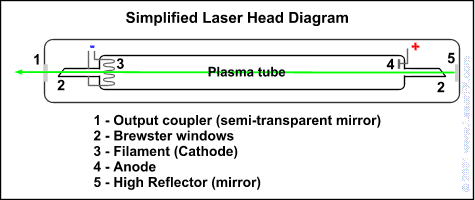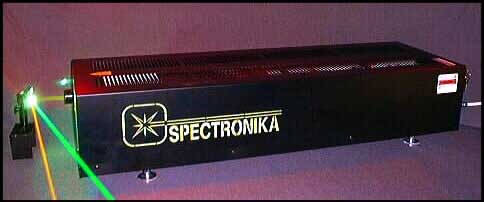
How Lasers Work

http://www.laserfx.com/Works/IndexWorks.html
How Helium and Neon (HeNe) Lasers work
-First there are glass tubes (what are a partial vacuum) that are filled with a combination of gases (in this case, helium and Neon). Neon and Florescent tubes will work. The gas is energized by electrodes at both ends of the tube by an electric current, which is through the electrodes. The electrons will jump to a higher valence shell, also known as an excited state. The electrons will want to return to the ground state, but the energy that excited the electrons is emitted in photons. This process is called spontaneous emission. The laser uses mirrors, normally at the ends of the laser, to get the photons to move coherently. The travel of the photons from the mirror, back through the gas is why we see an emitted color. and the waves will be traveling parallel in the tube. When the photons reach a specific intensity, they will pass through the mirror as laser light.1&3
 This is an image of how lasers work on the atomic level. The electron will
travel from the ground
This is an image of how lasers work on the atomic level. The electron will
travel from the ground
state to an excited orbit, and then back down to the ground state.
http://www.laserfx.com/Works /IndexWorks.html
/IndexWorks.html
It is important to make sure that the mirrors are coated, so they can reflect the light instead of absorbing it. This makes sure that less than 10% of the light is allowed to "leak" out of the tube. 3
http://www.laserfx.com/Works/IndexWorks.html
-The photons the HeNe emit are a reddish color.
How Lasers Make Light
-Our company will use mostly the screen effect and white light lasers. However, there are times when KAL will also use an Argon laser. This laser will give off a cyan beam, but it can be split into blue and yellow using a prism. A Krypton laser can give off a variety of colors with the help of a prism, or Kr can emit a reddish color like that of HeNE.
|
http://www.laserfx.com/Works/IndexWorks.html This is an exciter. The exciter is the power supply of the laser. It must be cooled down by either air or by water. This power supply uses high voltages, which gets converted into the DC voltages needed to power the plasma tube that is located in the laser head.3 |
-There are 6 major sub-systems in a laser show2
-The laser Power supply: This is the generator that supplies energy to
excite the electrons.
-The laser projector: This is the device used to display the laser onto the
desired surface.
-Scanners: This is one of the most important parts of the system, it is
normally referred to as galvos. It has a small coil of wire wound
around a light weight aluminum bobbin.2
-Control Console: This is where the laserist operates the show
-Laser Graphics system: This is how all of the animations are made
possible.
-Outboard equipment: This is where the fog machine is located for the
laser show. Fog is used to help illuminate the laser display.
 |
|
http://www.laserfx.com/Works/Works2.html A high power, air-cooled copper vapour laser - Photo courtesy of Spectronika |

http://www.laserfx.com/Works/Works2.html

http://www.laserfx.com/Works/Works2.htm
The light given off by lasers differ from regular light. Regular light travels in all different directions. This is shown by the Incoherent light waves picture. The light coming from a laser is temporarily coherent. Which means that the light waves flow in smooth parallel paths. They also travel in the same direction. ( as depicted in the coherent light waves picture) Because the laser light is coherent, is does not disperse into many different places. Instead, it is fixed on a certain point.3
Different Laser Show effects:
Lasers shows can be divided into two main categories, Beam effects and Screen effects.
-Beam effects: “Beam effects are the effects created by the laser beam itself traveling through the air towards or over the viewers.”2
-There are two types of Beam effects:
-Static beams do not move. These beams are switched on and off. Static beams are the most harmful type of laser effects and they must be shielded from the audience for their safety.
-Dynamic (scanned) beam effect are beams that move instead of beingturned on and off. They are generated by X-Y scanning systems. These beams include fans of beams, beam sequence, cones and tunnels of beams.
-Screen effects: “Screen effects are projected laser effects which require a screen.”2 These laser shows can be displayed on walls, buildings, the sides of mountains, and even clouds.
*1- How Lasers Work. Available Online.
<http://www.gregdowing.com/flash/> 14 March 2005.
*2- How Laser Shows Work- Introduction Available Online.
<http://www.laserflex.com/Works/IndexWorks.html> 14 March 2005.
*3- How Laser Shows Work- Laser & Excited. Available Online.
<http://www.laserfx.com/Works/Works2.html> 6 April 2005.
**This page is not that of a real company, but is for a chemistry assignment for general chemistry 140 at Monmouth College**
Back to KAL Home Page Fire Work Music Back to Laser Page White Light Lasers